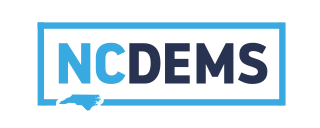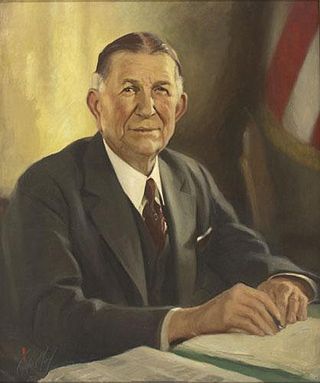| |||||||||||||||||
| |||||||||||||||||
| |||||||||||||||||
| Elections in North Carolina |
|---|
 |
The 1936 North Carolina lieutenant gubernatorial election was held on November 3, 1936. Democratic nominee Wilkins P. Horton defeated Republican nominee J. Samuel White with 70.14% of the vote.
| |||||||||||||||||
| |||||||||||||||||
| |||||||||||||||||
| Elections in North Carolina |
|---|
 |
The 1936 North Carolina lieutenant gubernatorial election was held on November 3, 1936. Democratic nominee Wilkins P. Horton defeated Republican nominee J. Samuel White with 70.14% of the vote.
Primary elections were held on June 6, 1936. [1]
| Party | Candidate | Votes | % | |
|---|---|---|---|---|
| Democratic | Paul D. Grady | 162,221 | 37.77 | |
| Democratic | Wilkins P. Horton | 138,631 | 32.28 | |
| Democratic | George McNeill | 128,661 | 29.96 | |
| Total votes | 429,513 | 100.00 | ||
| Party | Candidate | Votes | % | |
|---|---|---|---|---|
| Democratic | Wilkins P. Horton | 217,230 | 51.06 | |
| Democratic | Paul D. Grady | 208,248 | 48.94 | |
| Total votes | 425,478 | 100.00 | ||
| Party | Candidate | Votes | % | ±% | |
|---|---|---|---|---|---|
| Democratic | Wilkins P. Horton | 555,390 | 70.14% | ||
| Republican | J. Samuel White | 236,438 | 29.86% | ||
| Majority | 318,952 | ||||
| Turnout | |||||
| Democratic hold | Swing | ||||
Southern Democrats are affiliates of the U.S. Democratic Party who reside in the Southern United States. Most of them voted against the Civil Rights Act of 1964 by holding the longest filibuster in American Senate history while Democrats in non-Southern states supported the Civil Rights Act of 1964. After 1994 the Republicans typically won most elections in the South.

The 1954 United States Senate elections was a midterm election in the first term of Dwight D. Eisenhower's presidency. The 32 Senate seats of Class 2 were contested in regular elections, and six special elections were held to fill vacancies. Eisenhower's Republican party lost a net of two seats to the Democratic opposition. This small change was just enough to give Democrats control of the chamber with the support of an Independent who caucused with them.

The 1948 United States Senate elections were elections which coincided with the election of Democratic President Harry S. Truman for a full term. The 32 seats of Class 2 were contested in regular elections, and one special election was held to fill a vacancy. Truman had campaigned against an "obstructionist" Congress that had blocked many of his initiatives, and in addition the U.S. economy recovered from the postwar recession of 1946–1947 by election day. Thus Truman was rewarded with a Democratic gain of nine seats in the Senate, enough to give them control of the chamber. This was the last time until 2020 that Democrats flipped a chamber of Congress in a presidential election cycle.

The North Carolina Democratic Party (NCDP) is the North Carolina affiliate of the Democratic Party. It is headquartered in the historic Goodwin House, located in Raleigh.

The North Carolina United States Senate election of 1972 was held on 7 November 1972 as part of the nationwide elections to the Senate, and coinciding with the 1972 presidential election. The general election was fought between the Republican nominee Jesse Helms and the Democratic nominee Rep. Nick Galifianakis. Helms won the election, becoming the first Republican to win a Senate seat in North Carolina since 1903, and the first to hold this seat since 1871.

The 1988 United States presidential election in North Carolina took place on November 8, 1988, and was part of the 1988 United States presidential election. Voters chose 13 representatives, or electors to the Electoral College, who voted for president and vice president.

The 1920 United States presidential election in Alabama took place on November 2, 1920, as part of the 1920 general election, in which all 48 states participated. Alabama voters chose twelve electors to represent them in the Electoral College via popular vote pitting Democratic nominee James M. Cox and his running mate, Assistant Secretary of the Navy Franklin Roosevelt, against Republican challenger U.S. Senator Warren G. Harding and his running mate, Governor Calvin Coolidge.

The 1952 United States presidential election in North Carolina took place on November 4, 1952, as part of the 1952 United States presidential election. North Carolina voters chose 14 representatives, or electors, to the Electoral College, who voted for president and vice president.

The 1944 United States presidential election in North Carolina took place on November 7, 1944, as part of the 1944 United States presidential election. North Carolina voters chose 14 representatives, or electors, to the Electoral College, who voted for president and vice president.

The 1940 United States presidential election in North Carolina took place on November 5, 1940, as part of the 1940 United States presidential election. North Carolina voters chose 13 representatives, or electors, to the Electoral College, who voted for president and vice president.

The 1936 United States presidential election in North Carolina took place on November 3, 1936, as part of the 1936 United States presidential election. North Carolina voters chose 13 representatives, or electors, to the Electoral College, who voted for president and vice president.

The 1938 Massachusetts gubernatorial election was held on November 8, 1938.

The 1940 North Carolina gubernatorial election was held on November 5, 1940. Democratic nominee J. Melville Broughton defeated Republican nominee Robert H. McNeill with 75.70% of the vote.

The 1936 Florida gubernatorial election was held on November 3, 1936. Democratic nominee Fred P. Cone defeated Republican nominee E.E. Callaway with 80.91% of the vote.

The 1930 Tennessee gubernatorial election was held on November 4, 1930. Incumbent Democratic Governor Henry Hollis Horton defeated Republican nominee C. Arthur Bruce with 63.8% of the vote.

Elections were held in Illinois on Tuesday, November 3, 1936.

The 1823 Delaware gubernatorial special election was held on October 7, 1823. A few months into his three-year term, Democratic-Republican Governor Joseph Haslet died in office, elevating State Senate Speaker Charles Thomas to the governorship and triggering a special election in 1823. Justice of the Peace David Hazzard ran as the Democratic-Republican nominee to succeed Thomas and faced State Senator Samuel Paynter, the Federalist nominee. Paynter narrowly defeated Hazzard, regaining the office for the Federalists.

The 1826 Delaware gubernatorial election was held on October 3, 1826. Incumbent Federalist Governor Samuel Paynter was barred from seeking re-election to a second consecutive term. State Senator Charles Polk Jr. ran as the Federalist nominee to succeed Paynter, while 1823 Democratic-Republican nominee David Hazzard once again ran as his party's nominee. Polk ended up defeating Hazzard by a narrow margin, barely holding onto the governorship for the Federalists.
The 1984 North Carolina lieutenant gubernatorial election was held on November 6, 1984. Democratic nominee Robert B. Jordan defeated Republican nominee John H. Carrington with 53.70% of the vote.

The 1956 North Carolina lieutenant gubernatorial election was held on November 8, 1956. Democratic nominee Luther E. Barnhardt defeated Republican nominee Joseph A. Dunn with 66.71% of the vote.